Five Things You Probably Didn’t Know About Chernobyl
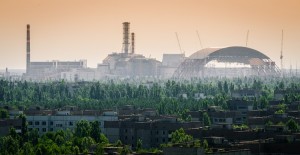
Figure 1.) Chernobyl Nuclear Power Plant with the abandoned town of Pripyat in the foreground. The large arch structure is the New Safe Confinement structure under construction. Via Chernobylguide.com
Chernobyl was by far the worst nuclear power plant accident in history. The explosion and subsequent release of radioactivity forced the long-term evacuation of nearly 135,000 people from a 30-kilometer exclusion zone surrounding the plant [1]. When I was younger and wanted to learn more about nuclear power, I was fascinated with the Chernobyl disaster. This was partly because it was one of the only two books in my elementary school library on the topic, but also because it's constantly used as a cudgel to beat proponents of nuclear power into submission. However, when you look at the "facts" that opponents of nuclear power cite about the accident, they are often dead wrong.
Nuclear power advocates have done a great job through various forms of media trying to combat the false claims, and you may have already heard some of these facts. You have probably heard that the official death toll from Chernobyl is 31 killed from acute radiation sickness (ARS) [2] and that linear no-threshold models predict up to 4,000 premature deaths from cancer due to radiation exposure [3](never mind that these estimates are based on a heavily disputed model). You have probably heard that people still live in the exclusion zone, despite government orders saying they can't. [4] And lastly, you probably know that high-power channel reactor, or RBMK reactors, are not operated in the western world and are gradually being phased out of operation and replaced [5]. By now, if anyone tries to tell you that an accident like Chernobyl could happen here in the United States or elsewhere, there is a 99.999% chance that person knows nothing about nuclear power. You'll have to politely fill them in on the details.
I don't want to harp on these points too much since I think they are widely known. Rather, I would like to share some of the more interesting things I have learned throughout my studying of the accident that you probably haven't heard of. Given that it has been 32 years to the day of the accident, many interesting things have been seen related to the disaster, and I would like to highlight some of them.
![]() 1. The construction of Chernobyl was mired in scandal, and safety concerns were ignored.
1. The construction of Chernobyl was mired in scandal, and safety concerns were ignored.
This ignorance should come as no surprise, but throughout Chernobyl's history, there has been one controversy after another. Chernobyl and all similar plants were constructed and operated in a country and ideology that did not emphasize the safety of a power plant, but rather, embraced a design that was massive and had inherent design flaws that would never be considered acceptable in western nuclear countries. Simple things like not including a containment structure or being unstable at low power levels highlight the inherent design flaws of the RBMK. The craziest part about this, however, is that a lot of people who could have done something about this in the USSR were not only aware of these flaws but did nothing about it. In fact, transcripts from Politburo meetings after the disaster revealed how even energy ministers had little faith in the RBMK design. The following quotes come from a larger politburo meeting transcript from Der Spiegel [6]
G.A. Shasharin (deputy energy minister): The personnel had no idea that this type of reactor can release so much energy. We didn't know it either. We were enthusiastic about this reactor but never truly convinced of its safety. There was only one protective system, and everyone assumed that it was no good. The Smolensk and Kursk nuclear power plants, as well as the two near Leningrad, should also be shut down. They can't even be refurbished anymore.
Anatoli Mayorets (energy minister): This reactor model is no good. There was a similar accident at the Leningrad nuclear power plant back in 1975. No one ever dealt with it. And the same thing already happened in Chernobyl in 1982, except that there was no release of radioactive material that time. No one learned anything from that accident, either. Foreign sources show that the West has already simulated the Chernobyl accident. Should we continue to lie to the IAEA? Moreover, we must stop building cities next to nuclear power plants just because it's cheaper.
Clearly, top energy officials were well aware of these flaws with the Soviet reactor program, and they were not just limited to Chernobyl. Western engineers understood this (hence, why RBMK style reactors were never built for electricity), and highlights a stark difference in safety culture. This type of negligence would never be tolerated in the United States, proven by the fact that we have never had a commercial nuclear accident fatality. Furthermore, Soviet officials were also warned by the KGB multiple times and ignored all of these red flags [7]. The KGB had raised concerns about how the construction of the plant was not up to code, and that the workers were not aware of the same safety risks that engineers were.
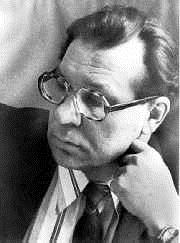
Figure 2.) Valery Legasov, USSR Inorganic Chemist, and Chernobyl Whistleblower. (Wikipedia)
Valery Legasov, a prominent Soviet inorganic chemist and member of the Academy of Sciences of the USSR, was a vocal critic and raised his concerns about the RBMK design among fellow scientists and politicians. He believed that there were many guilty parties and that a general culture that valued quantity over quality fostered by the communist government was to blame. He is quoted as saying "[Chernobyl] was the apotheosis of all that is wrong in the management of the national economy and had been [for many decades]" [8]. No one had really believed him until the accident. On April 27, 1988, two years and one day after the accident, he committed suicide. On April 28, he was to present the results of the investigation to the politburo. There is an excellent BBC movie (with a bit of fear-mongering at parts) about this here.
2. The immediate surrounding area of the plant is a wildlife cornucopia
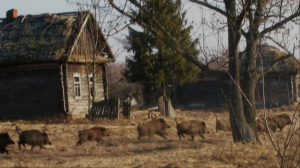
Figure 3.) Wild boars are roaming the Chernobyl exclusion zone. Image Valeriy Yurko.
During undergrad, I had the fortune of taking a general education course called "Animals in Pop Culture" (a true GPA killer...) where we were asked to write a paper about animals related to your area of study. While there are certainly plenty of nuclear-related topics that could be related to both nuclear science and animals, I wanted to look into the wildlife around Chernobyl, anticipating a then-upcoming documentary called Life After: Chernobyl, which focused on this topic exactly. Perhaps I was paranoid, but I saw writing the paper as a good excuse to immerse myself in the topic to prepare for any potential anti-nuclear bias (something that everyone should be prepared for when watching a documentary about nuclear disasters). While folklore suggests that the land around the reactor is filled with two-headed mutant animals and giant radioactive catfish, a lot of studies have shown that the wildlife around the plant now is perhaps more vibrant now than it was before the disaster [9] [10].
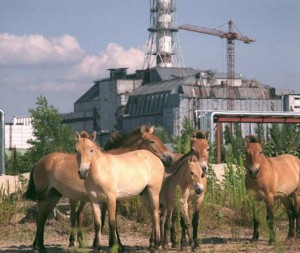
Figure 4.) Przewalski's horse in front of Chernobyl unit four. Note the smaller, younger horses present. (Wikipedia)
This may stun some people, but these studies are showing that the impact of mankind on nature is more profound than the impact of the largest commercial nuclear disaster. These studies show that threatened species such as Przewalski's horse and European bison have not only returned to the region, but they are in fact thriving, not to mention the hundreds of other non-endangered species that are also thriving in this wildlife sanctuary. In fact, some studies show similar numbers of mammals in the Chernobyl exclusion zone as they did in other nearby nature reserves [11]. I'm sure you're asking...
"Doug?? Are you really suggesting that we need more nuclear accidents to preserve nature??"
Of course not. All I am pointing out is that when you look into some of these accidents, ones that are often touted as reasons not to pursue nuclear energy further, the "environmental impact" argument really begins to fall apart. While there was certainly an exodus of wildlife from the exclusion zone for six months following the accident, wildlife still returned to the "contaminated" area. I don't think people, in general, give animal's instinct enough credit. Animals typically don't tend to stick around in areas where they die, let alone thrive in them. This leads to other questions, such as how can this plethora of animals survive off the land in an area we deem too dangerous for ourselves? Is it time to re-evaluate fundamentally what we understand about low-level radiation and its effects on living species? Did Doug get an A on his paper?
3. Some microorganisms thrive in the highly radioactive remains
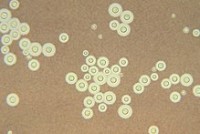
Figure 5.) Cryptococcus neoformans, a radiotrophic fungus that can be found inside the Chernobyl reactor (Wikipedia)
While there is an abundance of wildlife that has returned to the area, nothing can live inside of the reactor, right? Well, if you ignore the birds that nest inside of the sarcophagus and throughout the power plant's ruins [12], you might be safe in assuming so. But, in 1991, a few organisms were found growing inside of the radioactive remains of the power plant, where scientists then speculated nothing could possibly live. However, a thick black slime was found growing on the walls in the highly radioactive areas [13] composed mainly of three different organisms, Cladosporium sphaerospermum, Wangiella dermatitidis, and Cryptococcus neoformans [14].
How could this be? It turns out that these three fungi have something that every single person on the planet has in their skin, melanin. While they have it in significantly higher amounts, melanin has a ton of radicals, or unreacted molecules with free electrons, where it is hypothesized that this melanin, may convert energy from radiation into usable energy, i.e., radiosynthesis. In a laboratory setting, these fungi and an "albino" (melanin-free) control group were exposed to gamma radiation environments 500 times that of background radiation. Researchers found that the fungi's melanin adapted to the higher radiation within 20 to 40 minutes, and grew at a rate three to four times faster compared to the control group [15].
This sounds like this is the beginning of something incredible. NASA realizes this as well [16], since they are sending shipments of these fungi to the International Space Station to study the effects of cosmologic radiation on these cells. Patents have been filed to enhance the growth of cells by increasing their melanin content [17]. The research group that filed the patent believes that radiosynthesis may have been paramount in the formation of early life on earth, which would have allowed for early melanized fungi to behave like autotrophs. This is incredible to me because, in one of the worst industrial accidents, we may have gained an enormous amount of insight into our origins. Also, the things that can be learned from studying these fungi can only stand to benefit humanity whether it be radiation protection for future space exploration missions, or in understanding how biological organisms interact with radiation. This is remarkable, and something seldom talked about with Chernobyl.
4. Heroism prevented the disaster from getting even worse.
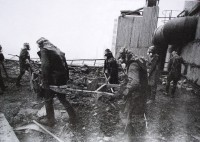
Figure 6.) Liquidators in lead-lined suits remove debris from the explosion from reactor #4. The higher levels of radiation burned the film at the bottom of the picture. Via energia-nuclear.net
The way the Chernobyl disaster was handled after the accident has been open to much criticism. I'm sure that any health physicist that reads about the liquidators, the nearly 600,000 soviet personnel called upon to clean up the accident, would be kept up at night upon learning about the "brute force" methods employed to clean up after the disaster. The term liquidator applies to a wide range of personnel, whether they be the control room operators in the reactor at the time of the incident, the firefighters that battled the flames from the reactor, or even the officials that coordinated evacuation efforts of the nearby town of Pripyat. Essentially, everyone involved with the Chernobyl disaster was considered a liquidator, sometimes referred to as a "bio-robot."
The cleanup was an extraordinarily large task and is brilliantly shown with raw footage in this documentary (one of my favorites about Chernobyl, despite the unsubstantiated fear-mongering about radiation during the second half). Workers, many of whom were in the red army reserves, approached the cleanup as if it were a battle. Helicopters would drop bags of sand, lead, and boron to try and smother the flames in the still glowing reactor core [18]. Workers tunneled underneath the reactor to create a cement slab to prevent fuel from melting into the aquifer situated beneath the plant [19]. Others worked on the roof to remove highly radioactive debris, including chunks of the graphite moderator, by hand, wearing only hand-made lead-lined suits, worked in approximately one-minute shifts to try and limit exposure. All of this was occurring when a second, even greater threat was looming.
Rooms beneath the reactor core had filled with water, both from ruptured pipes during the explosion and from fire-fighting efforts. There were also bubbler pools beneath the core containing cooling water for emergency systems. The concern was that this molten fuel could melt through the cement floors and eventually hit this pooled water, triggering a massive thermal explosion. This was dangerous since the neighboring reactors would also be destroyed, and their radioactive contents would be dispersed in the explosion. These rooms could be drained only if valves were manually opened by an operator.
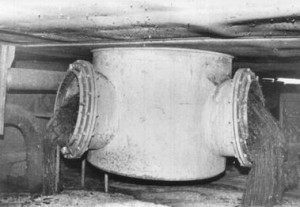
Figure 7.) Corium, a mixture of uranium, graphite, and concrete is seen solidified after flowing through a pipe beneath the reactor (Wikipedia)
These pools were fully drained, and a second explosion was prevented (obviously), but how it was drained is still subject to speculation [20] [21]. A popular account is that a "suicide squad" of three engineers waded into the knee-deep water in wetsuits to find and manually turn these valves. Alexei Ananenko and Valeri Bezpalov, the plant engineers who knew the location of the valves, and their supervisor, Boris Baranov were the three men who opened the valves, but many say that they succumbed to acute radiation sickness following their heroic act. However, Andrew Leatherbarrow author of the book Chernobyl 1:23:40 was able to determine that this tale was a tall one at best. He found out that the two engineers were still alive, where Ananenko still, in fact, works in the nuclear industry. Only their supervisor, Baranov, had passed away in 2005 from heart failure.
While the former story certainly does make for good cinema, the latter is no less heroic in my opinion. Everyone involved in that cleanup should be treated as such since their efforts without a doubt saved the lives of many more. While multiple studies were conducted and concluded that the incidents of cancer amongst the liquidators were no higher than in non-exposed control groups [22] [23], liquidators exposed to the highest radiation levels were more likely to exude symptoms of PTSD [24]. Just another example highlighting that the fear of radiation may actually be more dangerous than the radiation itself. While there may be mounting evidence to suggest just this, the fear was still very real to these brave liquidators. They were told those risks, and still bravely did what they needed to do. All of humanity owes them a debt of gratitude.
5. The new sarcophagus is a modern-day engineering marvel.
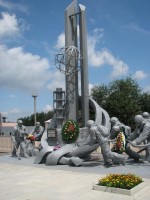
Figure 8.) The Chernobyl liquidator's monument. Via Lindsay Fincher
The work that the liquidators performed was not done in vain, as they were clearing the way for the first confinement shelter, the sarcophagus, to be constructed for housing the ruined remains of the Chernobyl reactor. This structure was not intended to be long-term, but rather something that could be constructed quickly by workers. The estimated lifespan of this sarcophagus was about 20 to 30 years and would need a suitable, long-term replacement. Enter, the New Safe Confinement (NSC) shelter.
The NSC is being constructed by the French consortium, Novarka. It was designed to not only be large enough to house the entire reactor and older confinement structure but also so that it would last for at least 100 years [25]. Doing this presented a new set of challenges. Since ALARA principles were required, the structure needed to be built in an area where background radiation was within safe limits. To do this, the NSC was built just offsite from the reactor behind a massive shielding wall to protect the workers. Once enough of it had been constructed, it was moved on a set of rails over the remains of the reactor, where the rest of the construction was completed.
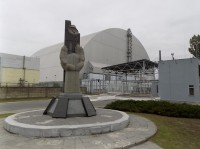
Figure 9.) The NSC placed over the Reactor #4 at the Chernobyl Nuclear Power Plant. (Wikipedia)
Did I say it was massive? Well, let me say it again. IT'S MASSIVE. This made the NSC the world's largest movable structure. In fact, the NSC is so large that it could completely cover the Notre Dame Cathedral and weighs triple that of the Eiffel Tower [26]. Not to mention, it also houses two remotely operated cranes from its ceiling that will aid in the partial deconstruction of the sarcophagus, and for handling and moving the radioactive debris for safe storage. Truly a first of its kind structure.
![]()
Thirty-two years gives a lot of time to reflect on the incidents of that fateful April day. While no one can deny that it certainly was a disaster, we can be thankful that the stark contrast between Western and Soviet reactor design, safety culture, and operational procedures are both literally and figuratively worlds apart. While Chernobyl is certainly not the bellwether for existing or future nuclear power (I cannot emphasize this enough), it does provide insight on a variety of different subjects. Whether it be how countless individuals risked an unknown fear to keep a bad situation from getting worse, or that nature is once again a beautiful source of scientific discovery and inspiration, showing that there is light, even in the darkest of situations. We need to do our best to not only remember the bad but fully utilize the good that came from this unforgettable disaster.
References
[1] P. Steadman and S. Hodgkinson, "Nuclear Disasters & The Built Environment , A report to the royal institute of... pp 55".
[2] W. Hallenbeck, Radiation Protection, p. 15, 1994.
[3] E. Cardis, D. Krewski, M. Boniol, V. Drozdovitch, S. C. Darby, E. S. Gilbert, S. Akiba, J. Benichou, J. Ferlay, S. Gandini, C. Hill, G. Howe, A. Kesminiene, M. Moser and Sanch, "Estimates of the cancer burden in Europe from radioactive fallout from the Chernobyl accident," International Journal of Cancer, vol. 119, no. 6, p. 1224, 2006.
[4] P. Thompson and C. Beeler, "30 years after Chernobyl, these Ukrainian babushkas are still living on toxic land," [Online]. Available: https://www.pri.org/stories/2016-04-26/30-years-after-chernobyl-these-ukrainian-babushkas-are-still-living-their-toxic. [Accessed 12 April 2018].
[5] "RBMK Reactors," Wikipedia, [Online]. Available: https://en.wikipedia.org/wiki/RBMK#Further_development.
[6] C. Neef, "Documents Show Politburo Skepticism of Chernobyl," DerSpiegel, pp. http://www.spiegel.de/international/zeitgeist/this-reactor-model-is-no-good-documents-show-politburo-skepticism-of-chernobyl-a-752696.html, 24 March 2011.
[7] A. Krushelnycky, "Telegraph," 08 May 2003. [Online]. Available: https://www.telegraph.co.uk/news/worldnews/europe/russia/1429486/Chernobyl-threat-ignored-for-years.html.
[8] "Legasov Suicide Leaves Unanswered Questions," 19 April 2006. [Online]. Available: http://www.neimagazine.com/features/featurelegasov-suicide-leaves-unanswered-questions/.
[9] C. Barras, The Chernobyl Exclusion Zone is Arguably a Nature Reserve, BBC Earth, 2016.
[10] M. B. N. Wood, " The wildlife of Chernobyl: 30 years without Man," The Biologist, vol. 63, no. 2, pp. 16-19, 2016.
[11] T. Deryabina and e. al., "Long-term census data reveal abundant wildlife populations at chernobyl," Current Biology, vol. 25, no. 19, pp. R824-R826, 2015.
[12] T. Summer, "ScienceShot: Some Birds Thrive in Chernobyl's Radioactive Glow," 2014.
[13] "Major biological discovery...inside the Chernobyl reactor??," 29 May 2007. [Online]. Available: https://unitedcats.wordpress.com/2007/05/29/major-biological-discoveryinside-the-chernobyl-reactor/.
[14] D. Castelvecchi, "Dark Power: Pigment seems to put radiation to good use," Science News Online, 26 May 2007. [Online]. Available: https://web.archive.org/web/20080424001002/http://www.sciencenews.org/articles/20070526/fob5.asp
[15] E. Dadachova, R. Bryan, H. Xianchung, T. Moadel, A. D. Schweitzer, P. Aisen, J. Nosanchuck and C. Arturo, "Ionizing Radiation Changes the Electronic Properties of Melanin and Enhances the Growth of Melanized Fungi," PLos One, 2007.
[16] A. Thompson, "Chernobyl Microbes Are Heading to the International Space Station," VICE, 17 July 2016. [Online]. Available: https://motherboard.vice.com/en_us/article/d7yxza/chernobyl-microbes-in-space.
[17] E. Dadachova, "Radiosynthesis as an alternative energy utilization process in melanized organisms and uses thereof". United States of America Patent 8652827, 18 February 2014.
[18] S. Silvestri, "The Helicopters of Chernobyl," The Collective Mag, [Online]. Available: http://www.collectivemag.com/chernobyl-helicopters.
[19] Greenpeace, "What Happened in Chernobyl?," [Online]. Available: https://www.greenpeace.org/archive-international/en/campaigns/nuclear/nomorechernobyls/what-happened-in-chernobyl/.
[20] S. Kramer, "The Amazing True story behind the Chernobyl 'suicide squad' that helped save europe," Tech Insider, 26 April 2016. [Online]. Available: http://www.businessinsider.com/chernobyl-volunteers-divers-nuclear-mission-2016-4.
[21] The Chernobyl Gallery, "Timeline," The Chernobyl Gallery, [Online]. Available: http://chernobylgallery.com/chernobyl-disaster/timeline/.
[22] V. K. Ivanov, A. I. Gorski, M. A. Maksioutov, A. F. Tsyb and G. N. Souchkevitch, "Mortality Among the Chernobyl Emergency Workers: Estimation of Radiation Risks (Preliminary Analysis)," Health Physics, vol. 81, no. 5, pp. 514-521, 2001.
[23] M. Rahu, K. Rahu, A. Auvinen, M. Tekkel, A. Stengrevics, T. Hakulinen, J. D. Boice and P. D. Inskip, "Cancer risk among Chernobyl cleanup workers in Estonia and Latvia, 1986-1998.," International Journal of Cancer, vol. 119, pp. 162-168, 2006.
[24] H. Loganovsky, G. Tintle and B. Kotov, "The mental health of clean-up workers 18 years after the Chernobyl accident," Psychological Medicine, vol. 38, no. 4, pp. 481-488 , 2008.
Doug Hardtmayer is a graduate student studying nuclear engineering at The Ohio State University. His research is focused on pyroprocessing and fuel assessment. He is a member of the Society's Social Media Team.

